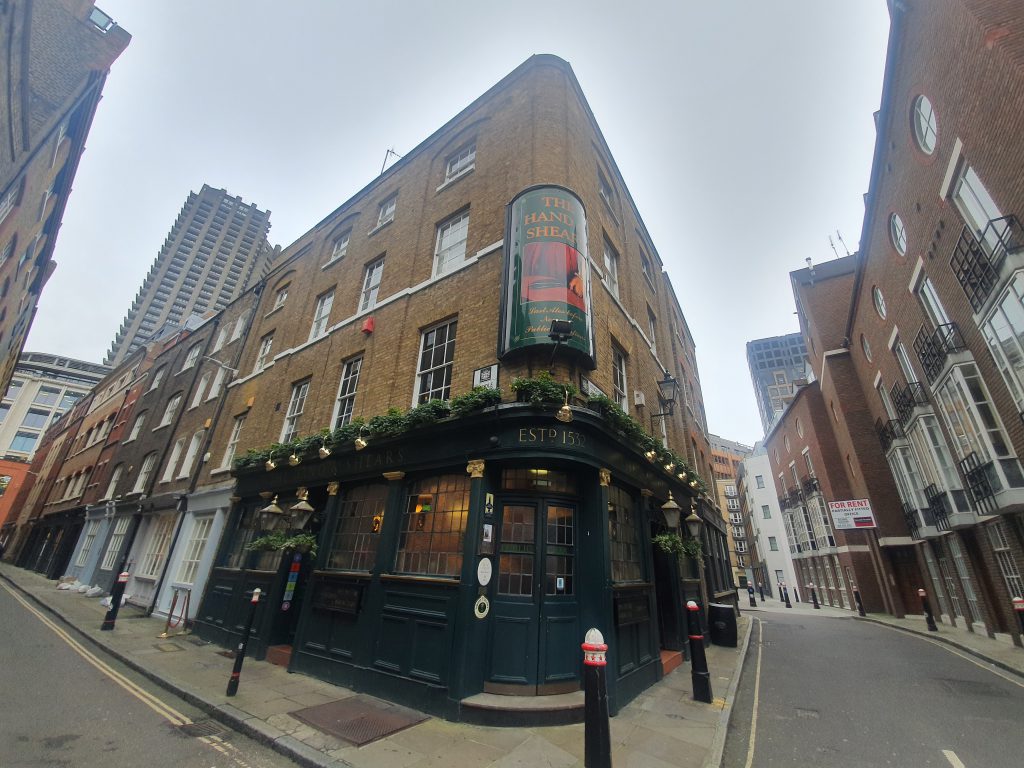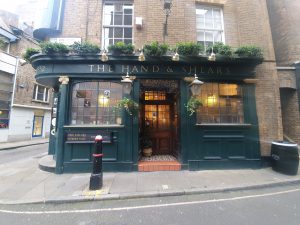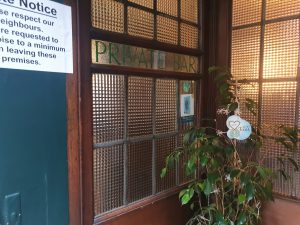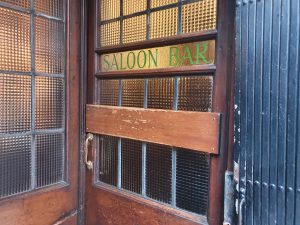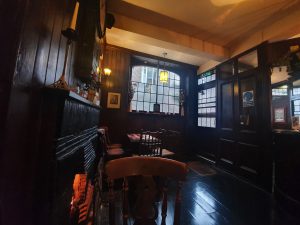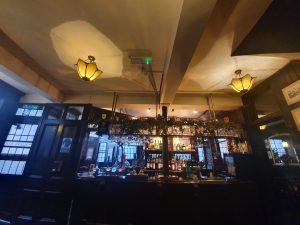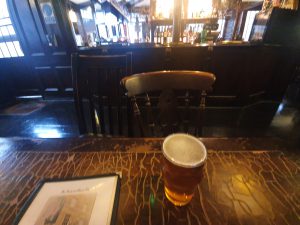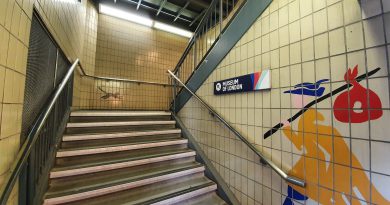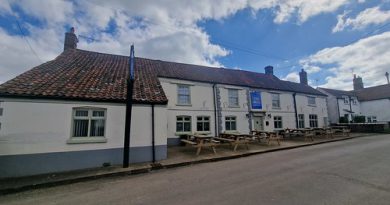London – Central London – The Hand and Shears
There has been a licensed premises at this site near Smithfields since the middle of the sixteenth century, although the current building dates to 1849. I visited it as it’s in the Good Beer Guide and it’s tucked away a little, just behind St. Bartholomew’s Church.
This location is noted on the list of CAMRA’s Historic Pub Interiors and they think that these signs date to around the 1930s. Usually swept away by endless refurbishments, the two separate areas of the pub still survive.
The pub is Grade II listed and, since it’s so comprehensive, this is the listed building record:
“The history of the Hand and Shears in Smithfield can be traced back to the C16. Whilst the name is recorded at this early stage, the plot it occupies and the surrounding street layout are of a slightly later date. The arrangement of Middle Street, between Cloth Street (to the east) and Kinghorn Street (west), is largely the product of the redevelopment of St Bartholomew’s Priory overseen by Lord Rich, for which leases of new properties were issued between 1597 and 1614. An etching of 1811 shows the prominent corner-plot position of the public house and the earlier building’s gambrel roof to Kinghorn Street with its two bar room entrances. The name ‘Hand and Shears’ references the important local cloth trade which thrived in the area, but it also relates to the famed St Bartholomew Fair which was held annually in August from 1133. The history of the Hand and Shears is closely intertwined with that of the fair, with important ceremonial traditions centred on the public house. One such example was referred to by E A Webb in a history of the fair of 1921:
‘There used to be a burlesque proclamation, the evening before the [official] proclamation by the Lord Mayor, by a company of drapers and tailors who met at the ‘Hand and Shears’… from whence they marched, shears in hand, to the archway leading from Cloth Fair into Smithfield, and announced the opening of the fair with a general shout and snapping of shears.’ (E A Webb, ‘Bartholomew Fair’, in The Records of St. Bartholomew’s Priory and St. Bartholomew the Great, West Smithfield: Volume 1, 1921, p300).
As with other public houses positioned close to markets or fairs, the Hand and Shears hosted what was known as a Pye Powder Court (the name originating from ‘pied puldreaux’, an old French term for a pedlar). From the medieval period, such courts had responsibility for keeping order and settling disputes between merchants and the public at markets and fairs. The court held at the Hand and Shears became particularly notable owing to the notorious vice and disorderly behaviour associated with the Bartholomew Fair. A sense of how the court would have appeared and functioned can be gleaned from a drawing of a session held in the panelled dining room of the Hand and Shears, published in Londina Illustrata in 1811: this shows the Pye Court judge at his bench with his secretary presiding over a dispute between two actors in theatrical dress. Ultimately, the scandal and excess drove the authorities’ efforts to supress it. This culminated in the prohibition in 1843 of all performances and shows, which inevitably caused the popularity of the fair to wane. A report from the Illustrated London News dated the 5 September 1846, lamented the consequent decline of the Pye Powder Court, where its duties had been ‘confined to the receipts of piccage, stallage and tollage’. The suppression of entertainments and the consequent lack of interest meant that, on the eve of the feast of St Bartholomew in 1850, ‘the mayor found no fair worth proclaiming’ (Webb, p317).
The decline of the Bartholomew Fair broadly coincided with – possibly even brought about – the redevelopment of the Hand and Shears and several neighbouring buildings. The rebuilding of the pub along with the adjoining house at 2 Middle Street was undertaken in around 1850 (sources record alternative dates of 1849 and 1852). The earliest known plan of the building’s bar arrangement is in a conveyance dated 1857, showing a similar configuration to the present arrangement, though with a smaller island counter and the stairs in a different position. The plan demonstrates that the main bar was entered from the corner door, with a private bar and distinct back parlour to Kinghorn Street, as remains the case. To the east, along Middle Street, was a large rectangular dining room with a specified area for bagatelle at its south end. The work of around 1850 appears to have been a private venture (the pub not being tied to a brewery at this stage). However, by 1872, the site was in the hands of the Whitbread Brewery. Save for a brief two-year spell when the freehold passed to the Lion Brewery, the Hand and Shears remained the property of Whitbread until 1896, when it was acquired by Barclay Perkins. In the same year the interior saw some remodelling, with a new internal vestibule added to the Kinghorn Street entrance, the island counter and stairs being reconfigured and a small office added at the back of the dining room. According to the plans, the proposed alterations were ‘before the Bench’ (the licensing magistrates) in February 1896 and were complete by December.
Into the 1920s some minor alterations were undertaken. In April 1920, plans were produced by F G Newnham (Barclay Perkin’s chief architect) to reposition the stairs to the cellar in order to extend the saloon bar (the same bar room formerly marked as the ‘parlour’). It is probable that this phase of ground-floor work also included the introduction of some of the present bar room windows and the two brick and tile fireplaces, which are characteristic of the period. Six years after the work to the ground-floor rooms, Newnham produced plans to introduce a new service area with a hatch for the first-floor dining area, followed in 1929 with a plan to integrate an adjacent sitting room and the main dining room. This investment prompted a remarkable boom in lunch and dinner sales: the pub recording that in 1930 it served 28,500 meals during the year, this increasing to 650 per week in 1931. Among those served were some esteemed visitors, including Prime Minister Stanley Baldwin on 20 October 1930 and, on 11 February 1931, Winston Churchill.
Since the inter-war work there have been only minor changes to the Hand and Shears. In 1962, the merged Courage and Barclay Brewery added a women’s WC in part of the former yard area to Kinghorn Street (accessed via an inserted door from the saloon bar). This has since been replaced with a first-floor WC and the rear passage now has steps from Kinghorn Street leading up to the first-floor level. In 1982-1983, the pub had to close for 18 months following structural damage caused by piling at Founders’ Hall on the opposite side of Kinghorn Street. Work was subsequently undertaken to strengthen the existing floors (consented in 1989), with new steel columns and beams inserted to the ground, first and second floors. The pub fittings, including the bar, screens and panelling were stored and reinstated whilst this was undertaken. In addition to the structural work, sensitive refurbishment of the ground-floor expanded the men’s WC into the rear (Middle Street) bar; this phase of work also involved the installation of the diagonal shelving over the servery, the replacement of the original iron columns and the reuse of an existing timber screen to create the counter in the first-floor room.”
I like that Winston Churchill and Stanley Baldwin visited the pub and by all accounts, the venue hasn’t been that much changed since the popped in for their lunch. I’d confidently say that they aren’t doing 650 lunches per week today, but there is a function room upstairs that allows them to host larger-scale dinners and events.
Warm and homely, with a fire going. This is the old saloon bar area of the pub and is probably the section that I wouldn’t have been in back in the day, I suspect I’d be saving a few pence and sitting in the public bar.
The main bar servery and this really is a delightful venue. The staff member was helpful and personable, so it felt like an inviting pub and I liked his engagement. There’s plenty to look at in the pub in terms of heritage and I’m pleased that this hasn’t been turned into a high-end gastropub. This is one of the advantages of the Good Beer Guide, it’s highly unlikely to send me into an expensive pub which is mostly all about the food. They do serve lunches here, but one of their strengths judging from reviews are their sausages rolls and pork pies. A review said that there was no jelly inside the pork pie inside which disappointed them, but it would have surprised and delighted me.
One negative review of the pub was:
“The place itself is grimy and very old – it is in desperate need of refurbishing. I wouldn’t go there again.”
And this is why companies refurbish places, they think it makes them better. But stampeding through this pub with a modernising plan would simply make things worse. Incidentally, everything was clean and organised on my visit, it was all really rather comfortable.
The beer choice was a little limited, but the Stiff Lip from Portobello Brewing was well-kept and at the appropriate temperature. I liked the surroundings of this pub and two American tourists came in who were merrily enthusing about the heritage and authenticity. The staff member said that the pub had very few customers last week, but it had picked up a little this week, but these remain challenging times for the hospitality industry in this part of London. I very much liked the pub though, the staff member was a clearly competent barman and he made the effort to engage with every customer, welcome them and say goodbye when they left.
Definitely a very worthy entry into the Good Beer Guide.

